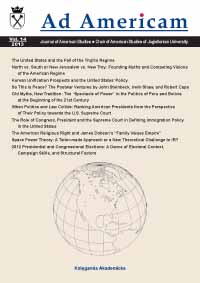When Politics and Law Collide: Ranking American Presidents from the Perspective of Their Policy towards the United States Supreme Court
When Politics and Law Collide: Ranking American Presidents from the Perspective of Their Policy towards the United States Supreme Court
Author(s): Paweł LaidlerSubject(s): Politics / Political Sciences
Published by: KSIĘGARNIA AKADEMICKA Sp. z o.o.
Summary/Abstract: Most scholars conducting research on the U.S. presidency analyze a particular presidency, ranking the ideology and political role of the chief executive, his rhetoric, interior policy program, foreign policy activity, and impact on the economy, as well as the role of the president as national commander of the armed forces. My main field of research is not the presidency, but the American judiciary. However, careful analysis of the theoretical and practical aspects of the functioning of American courts, and especially the U.S. Supreme Court, reveals the enormous impact of presidents on justice. Presidents nominate judges (and Supreme Court Justices), they may determine the scope of legal briefs presented in cases where the government is the party, and they can influence governmental participation as amicus curiae before the Court, which has become a vital tool of the United States in recent years. The growing political role of the Supreme Court, its enormous activity in applying judicial review, and its high position within the U.S. governmental structure have not only caused changes to the checks‑and‑balances system, but, above all, have resulted in the increased political activity of various presidents towards the tribunal. As a result, many chief executives consider their ‘judicial policy’ as one of the most important elements of their legacy. From this perspective, we may rank presidents who had the greatest (or the least) impact on the membership and operation of the Court (i.e. Washington, F.D.R., Lincoln versus Taylor, Harrison, Carter), as well as presidents who were willing to impose revolutionary changes in American constitutional law and succeeded (F.D.R., J.F.K.) or failed (Reagan). Analysis of the amicus curiae participation of the U.S. Solicitor General before the Supreme Court can also rank presidents as more or less active in their judicial politics. The aim of this paper is to show certain ranks of presidents with regard to their policy towards the Supreme Court, and also to present the ideological model which governed the majority of presidents in their politics towards the judiciary throughout U.S. history, leading to an ongoing clash of law and politics.
Journal: Ad Americam. Journal of American Studies
- Issue Year: 2013
- Issue No: 14
- Page Range: 81-98
- Page Count: 18
- Language: English

